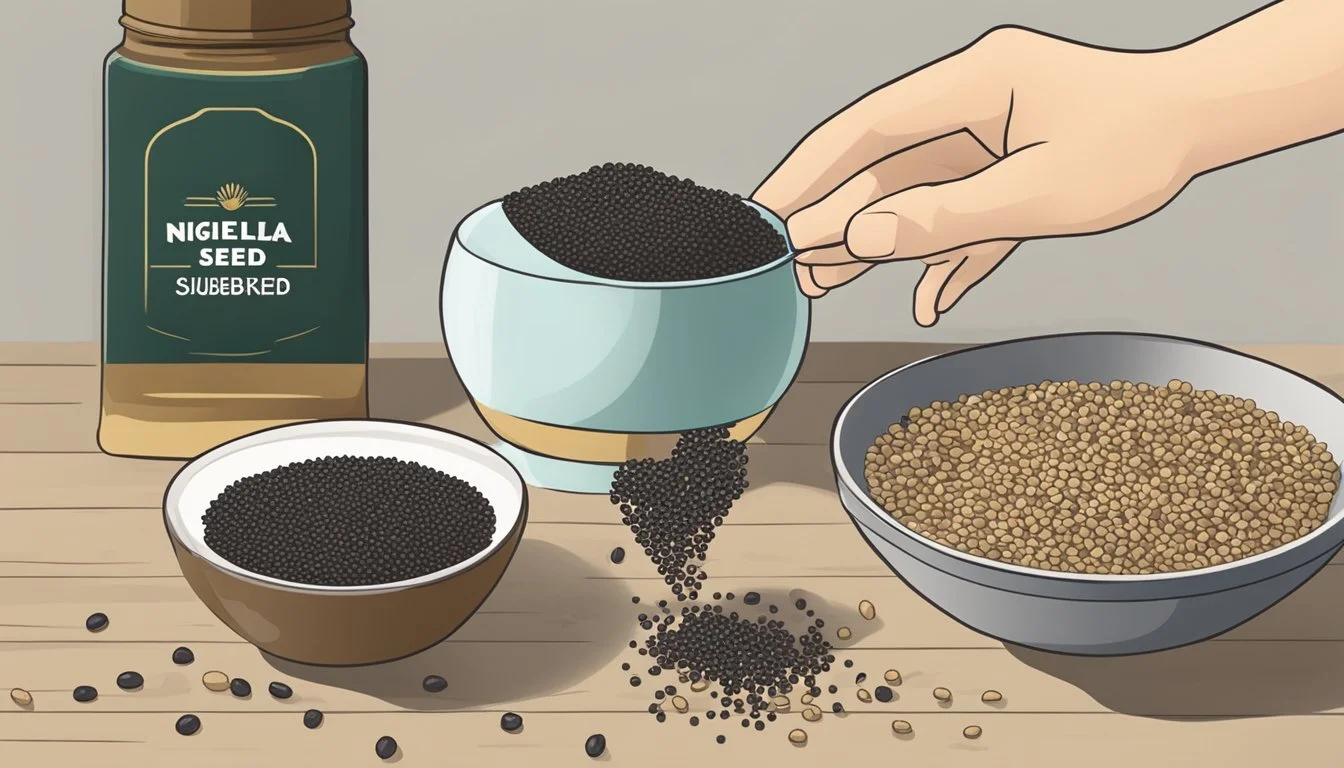How to Substitute Nigella Seeds for Sesame Seeds
A Simple Guide
Nigella seeds, with their oniony and oregano-like flavor profile, are a staple in various cuisines, adding a unique complexity to dishes. However, they may not always be readily available in every pantry or grocery store. When faced with a recipe that calls for these distinctive seeds, knowing how to effectively substitute them is crucial for home cooks looking to replicate or approximate the original flavor and texture. Sesame seeds, available in both black and white varieties, are often suggested as a suitable alternative due to their similarly nutty taste and crunchy texture.
While nigella seeds boast a slightly bitter, peppery flavor, sesame seeds tend to be milder and nuttier. In recipes where the visual appeal and texture of nigella seeds are desired, black sesame seeds serve as an excellent substitute, closely mirroring the appearance and providing a comparable crunch. White sesame seeds can also be used, though they lack the striking color contrast provided by their black counterparts. It's important to consider the differences in flavor intensity when using sesame seeds as a substitute; they might not impart the same sharpness as nigella seeds but can still enhance a dish with their own distinct notes.
Understanding Nigella Seeds
Nigella seeds, commonly known as black cumin or kalonji, are an ancient spice with numerous culinary and medicinal applications. This section delves into their origins, uses in cooking, and the health benefits they offer.
Origins and Botanical Background
Nigella seeds are harvested from Nigella sativa, a flower which is native to South and West Asia. The plant is also known by several other names, including Roman coriander, black caraway, and fennel flower. Historically, these seeds have been used in various cultures for culinary and therapeutic purposes for millennia.
Culinary Use and Flavor Profile
The seeds have a complex flavor profile, described as having notes of onion, oregano, and black pepper, making them a versatile ingredient in the kitchen. They are often used in Indian, Middle Eastern, and North African cuisines. Common applications include seasoning bread, adding to curries, or even as a substitute for sesame seeds with a ratio of 1:1.
Health Benefits
Nigella seeds are rich in nutrients, including antioxidants, protein, calcium, and magnesium. They also have anti-inflammatory properties which contribute to various health benefits such as aiding digestion and boosting the immune system. The seeds' oil is also treasured for its potential to alleviate a range of health issues.
Sesame Seeds Characteristics
Sesame seeds come in different varieties, each with a distinct taste and texture that determines its use in cooking. Here's how these small seeds stand out in culinary applications.
Sesame Seeds Variants
Sesame seeds are primarily found in two types: white sesame seeds and black sesame seeds. White sesame seeds are hulled and have a lighter color, while the black sesame seeds retain their hulls, giving them a darker hue. They are both used in different dishes depending on their flavor profiles and the visual appeal they offer.
Taste and Texture Comparison
White sesame seeds possess a subtly sweet and nutty flavor, with a less pronounced taste compared to their black counterparts. Black sesame seeds are known for a more pronounced earthy flavor and are slightly bitter. Both types of seeds add a pleasant crunch to dishes, with a crunchy texture that is particularly prized in baked goods and toppings.
Sesame Seeds in Cooking
Sesame seeds are incredibly versatile in cooking. They can be sprinkled over salads for an extra crunch, incorporated into bread doughs, and used as a key ingredient in tahini. When toasted, sesame seeds release their nutty flavor, enhancing the taste profile of a dish. Whether used as a primary ingredient or a garnish, they contribute both flavor and texture to culinary creations.
Nigella Seed Substitutes
When Nigella seeds are unavailable, several alternatives offer comparable flavors and textures suitable for most recipes. This section breaks down common substitutes and provides guidance for selection based on the dish’s requirements.
Suitable Nigella Seed Alternatives
Kitchen staples such as cumin seeds, fennel seeds, fenugreek seeds, poppy seeds, caraway seeds, and celery seeds serve as practical nigella seed substitutes. For those who might be looking for a replacement that resembles the appearance and texture of nigella seeds, black sesame seeds or white sesame seeds could be ideal.
Cumin seeds: Share an earthy and nutty flavor profile.
Fennel seeds: Offer a sweeter, licorice-like taste.
Fenugreek seeds: Provide a bitter and sweet aroma.
Poppy seeds: Suitable for their nutty and slightly sweet taste.
Caraway seeds: Impart a warm, bittersweet flavor with anise notes.
Celery seeds: Known for their mild, earthy, and slightly bitter taste.
Black/White Sesame seeds: Present a look similar to nigella seeds with a mild, nutty flavor.
One could also consider dried oregano or onion (powder or seeds) for their savory notes that mimic the complexity of nigella seeds.
How to Choose the Right Substitute
Selecting the right substitute for nigella seeds boils down to the flavor profile desired in the dish. If one aims for a substitute that has a nutty and earthy undertone, cumin seeds are a strong choice.
For recipes where a hint of sweetness is preferred, fennel seeds might be the best fit. Conversely, if the goal is to introduce a slightly bitter touch to the dish, one might opt for fenugreek seeds. In breadcrumb coatings and crusts where texture is crucial, poppy seeds can offer the necessary crunch.
In savory dishes such as stews, curries, and soups, celery seeds or onion can be used to complement other ingredients without overpowering them. For culinary applications that demand a visual similarity to nigella seeds, black sesame seeds are recommended, while white sesame seeds might be used in lighter-colored dishes.
It is important to remember that substitutes may alter the final flavor of a dish, so one should proceed with adjustments according to taste preference.
Substituting Nigella for Sesame
In recipes that call for sesame seeds, nigella seeds can be used as a substitute, taking into consideration their unique flavor and texture. Understanding the difference in measurements, flavor profiles, and potential allergy risks is essential for a successful substitution.
Converting Measurements
When substituting nigella seeds for sesame seeds, the one-to-one ratio is typically effective. This means if a recipe requires one tablespoon of sesame seeds, one may use one tablespoon of nigella seeds. However, due to the more robust flavor of nigella seeds, chefs may choose to adjust the quantity slightly based on personal taste preferences.
Sesame Seeds Nigella Seeds 1 tsp 1 tsp 1 tbsp 1 tbsp 1/4 cup 1/4 cup
Adjusting for Flavor Differences
Nigella seeds are known for their slightly bitter and peppery flavor with a hint of onion and oregano, which differs from the nutty and mildly sweet taste of sesame seeds. It is important to note this taste distinction, especially in dishes where sesame seeds are used primarily for their flavor rather than as a texture enhancer.
When nigella seeds are utilized as a nigella seeds substitute:
Add them earlier in the cooking process to mellow out the bitterness.
Use in baked goods, salads, and curries where their unique flavor can be appreciated without overwhelming the dish.
Considering Allergy Concerns
While both sesame seeds and nigella seeds are generally considered safe to eat, allergies to sesame are more common. One must be mindful of this when serving dishes with nigella seeds to guests who have sesame seed allergies, as they may also have sensitivities to other seeds.
Always inform guests of substitutes used in dishes to prevent possible allergic reactions.
Although not common, it's advisable for those with known seed allergies to consult with a healthcare professional before consuming nigella seeds as an alternative to sesame seeds.
Cooking With Nigella Seed Substitutes
In the realm of cooking, finding the right substitute for nigella seeds maintains the desired flavor profiles in dishes. This is particularly important when preparing certain Indian and Middle Eastern cuisines.
Recipes Apt for Substitution
Certain recipes are better suited for nigella seed substitutes due to their flavor compatibility and ingredient structure. Examples include:
Salads: Black sesame seeds can be used to add a similar visual appeal and a slightly nutty flavor.
Soups and Stews: Celery seeds offer comparable bitterness and earthiness while complementing the liquid medium.
Curries: Cumin seeds or ground cumin can replicate the peppery and bitter undertones characteristic of nigella seeds.
Middle Eastern Flatbreads: On naan or other flatbreads, either black or white sesame seeds mimic the texture and visual appeal.
Vegetable Dishes: Oregano provides a similar aromatic profile, enhancing the dish without overpowering it.
Meats: Given their robust flavors, meats can benefit from the substitution of nigella seeds with fennel seeds, tying in a sweet note.
Legumes: For dishes using lentils or beans, fenugreek seeds may be employed cautiously to impart a bold taste.
Impact on Dish Flavor and Texture
Substituting nigella seeds can alter both the flavor and texture of dishes, although the change can be subtle if the right substitute is chosen:
Earthy Aroma: Fennel seeds impart an earthy aroma but with a sweet twist, offering a distinct scent profile.
Bitter Taste: The bitterness of celery seeds reflects that of nigella seeds, making them ideal in dishes where this flavor is sought.
Peppery Notes: Cumin provides a warm, peppery aspect akin to nigella seeds, suitable for savory applications.
Texture: Black sesame seeds provide a similar crunch and visual quality, which can be especially beneficial in bread such as rye or sauerkraut bread.
Choosing the appropriate substitute for nigella seeds in cooking involves consideration of these factors to ensure the integrity of the dish's intended taste and textural experience remains intact.
Additional Considerations
When substituting nigella seeds with sesame seeds, it's important to consider both nutritional differences and culinary outcomes. Each substitute can impact the health benefits and the flavor profile of the final dish.
Nutritional Implications of Substitutes
Sesame seeds and nigella seeds offer different nutritional benefits. Nigella seeds are noted for their potential in maintaining cholesterol and blood sugar levels. However, sesame seeds bring their own health advantages, such as a higher content of calcium.
Nigella seeds: May have a positive effect on blood sugar control and cholesterol levels.
Sesame seeds: Good source of minerals, particularly calcium, and may contribute to overall health benefits.
Culinary Tips for Nigella Seed Replacement
The unique flavor and aroma of nigella seeds are not entirely replicated by sesame seeds. Nigella has a somewhat onion-like, oregano-esque flavor, while sesame seeds are nuttier.
When replacing nigella seeds with sesame seeds, toasting them lightly can enhance their flavor.
If the iconic aroma of nigella seeds is essential to the dish, consider using a pinch of cumin or oregano to replicate it.
Conclusion
In the culinary world, Nigella seeds, known for their oniony, oregano-like flavor and crunchy texture, can be replaced effectively with sesame seeds when necessary. Though they don't mirror the exact taste of Nigella seeds, sesame seeds offer a nutty flavor with their own level of complexity to dishes. They are a common substitute that's more widely available and can be used without altering the essence of the culinary creation.
When making the swap, cooks should consider the desired outcome in terms of both flavor and aesthetic. Black sesame seeds in particular provide a similar visual appeal and crunch, making them an especially suitable replacement in a variety of dishes. For an even closer match to the flavor profile of Nigella seeds, toasting sesame seeds before use can add depth and enhance their oil-rich character.
One should keep in mind the slight differences in flavor intensity. Sesame seeds tend to have a milder taste, so adjustments in seasoning may be necessary to achieve the desired flavor balance in a dish.
In summary, sesame seeds serve as a pragmatic and accessible alternative for Nigella seeds across diverse recipes. Their ability to impart a distinctive element to meals makes them a trusted choice among culinary professionals and home cooks alike.
Appendix
This section offers a quick reference and additional resources to further aid readers in understanding nigella seed substitutions for sesame seeds, focusing particularly on their applications in Indian and Middle Eastern cuisines.
Glossary of Terms
Spices: Aromatic substances commonly used to flavor food, often derived from plant parts.
Nigella Seeds: Also known as black cumin, kalonji, or black caraway, these seeds are used for their nutty and slightly bitter flavor in Indian and Middle Eastern dishes.
Sesame Seeds: Small, oil-rich seeds that are often used for their nutty taste and can be substituted for nigella seeds.
Indian Cuisine: A culinary style featuring a complex use of spices and flavors, where nigella seeds are frequently used.
Middle Eastern Cuisine: Culinary traditions from Middle Eastern countries that commonly employ a variety of aromatic seeds, including nigella.
Common Alternatives: Dehydrated chopped onions, onion flakes, cumin powder, dried oregano, and coriander seeds are all alternatives for nigella seeds.
Aromatic Seeds: Seeds like nigella, which are used for their strong aroma and flavor.
Additional Resources
For readers seeking more in-depth information on substituting nigella seeds with sesame seeds, the following resources are recommended:
Cookbooks: Look for Indian and Middle Eastern cookbooks that often have sections dedicated to understanding and using spices.
Culinary Websites: Many websites provide specific substitution ratios and how the flavor profiles match.
Spice Shops: Staff at specialized shops can offer insightful advice on spice substitutions based on flavors and regional cuisines.
Cooking Classes: Classes focusing on Indian and Middle Eastern dishes will educate one on the traditional and innovative uses of spices.
These resources can often be found listed in the Table of Contents of this article, under sections such as "Spice Substitution Guides" or "Regional Cooking Techniques."








